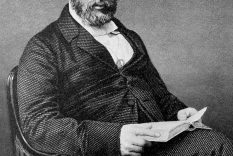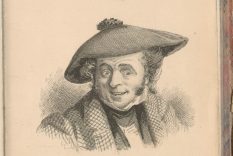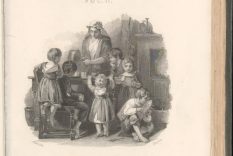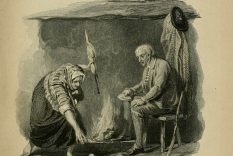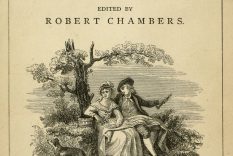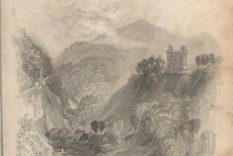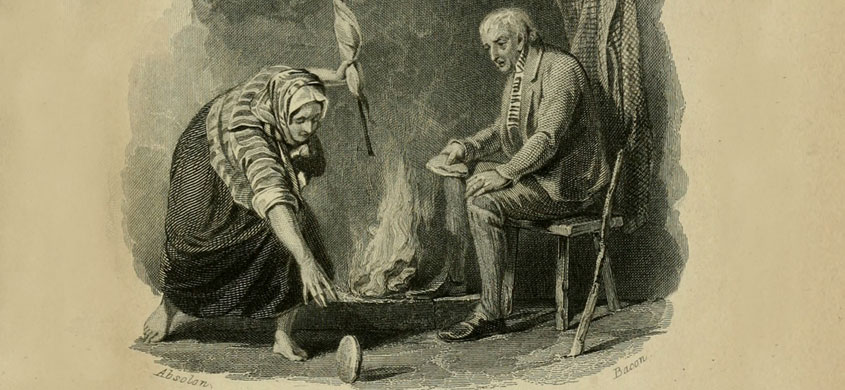
‘Popular Rhymes of Scotland’, with illustrations, chiefly collected from oral sources’, is a hairstin o Scottish verse, stories, folklore, proverbs an superstitions, editit bi Robert Chambers an first imprentit in 1826.
Whiles the main narrative o ‘Popular Rhymes’ is scrievit in staundart Inglish, it hauds a rowth o rich Scots wirds an expressions. It is by-ordinar fir a 19th century imprent in that its verbatim folktales gie extendit prose passages in Scots.
‘Popular Rhymes’ proved gey popular, gangin through various imprents atween 1826 an 1870 an wis an important source buik fir later folk studies. Frae an early interest in history an folklore, Robert Chambers, originally frae Peebles in the Scottish Borders, wid gang on tae become ane o the foremaist publishers in Britain. His interest in natural science wid lead tae him scrievin the anonymous ‘Vestiges of the natural history of creation’, an explosive evolutionary tract first imprentit in 1844 that wid cause a strushie amang scientific an religious thocht.
Lear mair aboot Popular Rhymes of Scotland
Born in 1802, Robert an brither William Chambers flittit frae Peebles tae Edinbrugh at the hin-end o the Napoleonic wars follaein thair faither’s bankruptcy in the claith tred. Frae a temporar buik staund on Leith Walk the brithers wid rise tae become prolific publishers.
Wi the advent o the steam press, throu the affordable ‘Chambers Journal’ – a mixter o literary, historical, political an scientific scrievins – literatur wis made appen tae tae a braid readership o aw social classes. Whiles in his younkers Robert had met up wi Walter Scott in Edinbrugh whaur Scott had fordered him in his ambitions as scriever an folklorist. Chambers scrieves in his introduction tae Popular Rhymes:
‘Other objects have since occupied me, generally of a graver kind; yet, amidst them all, I have never lost my wish to complete the publication of these relics of the old natural literature of my native country.’
Chambers’ ‘Popular Rhymes of Scotland’ can be considert an important document on baith the lang-estaiblisht an ongangin oral traditions o the Scots leid. It ceets a hantle o sources fir its folktales includin Wedderburn’s 1549 political tract ‘The Complaynt of Scotland’, which itsel references aulder Scottish tales sic as ‘Tam Lin’ an ‘The Red Etin’. Chambers identifies the lullaby ‘Baw Lula Law’ as bein owerset intae scriptural verse in ‘Ane collection of godlie and spirituall sangs’, as imprentit bi Andro Hart in 1621 – originally imprentit in 1567 as ‘The gude and godlie ballatis’ an kent as ‘The Dundee psalms’.
The trend o shawin verbatim folk tales in prent can be seen in later 20th century collections bi storytellers sic as Duncan Williamson, Stanley Robertson an in Ewan MacColl an Peggy Seeger’s ‘Till Doomsday in the Afternoon’. The stories ‘Tam Linn’, ‘Rashiecoats’ an ‘Jock an his Mother’ hae versions in Duncan Williamson’s ‘Thorn in the King’s foot: Folktales of the Scottish Travelling People’ (1987).
Some o the bairn rhymes an sangs in ‘Popular Rhymes’ hae bade on as kenspeckle verses in street games at least up till recent times. The likes o ‘Katie Beardie’ an ‘Aiken Drum’ hae survived in variant forms, heard in stage an TV shows sic as the highly popular ‘The Singing Kettle’. ‘Aiken Drum’ is alsae the name gie’d tae the eldritch craitur in Gallowa bard William Nicholson’s 1825 poem ‘The Brownie of Blednoch’ an is alsae gien as a sang anent the Battle o Shirramuir in James Hogg’s ‘Jacobite reliques’. A worthie cried Aiken Drum is mentioned in Scott’s Waverley novel ‘The antiquary’.
Whiles ‘Popular Rhymes’ is drawn maistly frae oral sources, Chambers maks a connection atween the oral tradition an Scottish literatur bi makkin mention o Walter Scott’s ‘Lay of the last minstrel’ (1805) an David Lyndsay’s ‘The Dreme’ (1528). ‘Katie Beardie’ features as a dance in Walter Scott’s novel ‘The fortunes of Nigel’, a tale set in the early 1600s.
In his introduction tae ‘The golden city’ (imprentit 1965), James T R Ritchie remerks on haein bocht an 1841 copy o Chambers’ ‘Popular Rhymes of Scotland’ an hou it had kittelt his interest. Ritchie wis dominie in a schuil on the mairch atween Edinbrugh an Leith. Wi some furder research an bi jottin doon the gemmes played bi the schuilbairns, he jaloused that these haudit rhymes an sangs that wir o lang-staunin vintage an had variations in places ootthrou Scotland, England, Wales an Ireland. In 1949 Ritchie produced a radio programme cried ‘The Singing Street’ an in 1951 made the film o the same name. ‘The Singing Street’ film is offert as the relatit video fir this wee windae.
‘Ram Tam Toosh; An anthology of Scottish verse for children’, edited by Alan MacDonald and Ian Brison, illustrated by John Harrold, cites ‘Popular Rhymes of Scotland’ as ain o its sources. First imprentit in 1982, ‘Ram Tam Toosh’ features a wheen o sangs an street gemmes in Scots.
Chambers’ anonymous an sensational ‘Vestiges of the natural history of creation’, a mellin o cosmological theories an evolutionary speculations positing spontaneous origins o life an transmutation o species, caught the attention o Charles Darwin an Thomas Huxley. The buik wis hale-hertitly condemned bi mony prominent Christians an heids o Victorian science. It wis Robert Chambers wha ettled at Huxley tae tak pairt in the faur-kent ‘Origin of species’ collogue wi Bishop Samuel Wilberforce at Oxford in 1860 – in which Huxley provokit Wilberforce whan he remerked that he wid raither hae a monkey fir a forebeir than be connectit wi a man (Wilberforce) wha yaised great gifts tae smuir the truth.
‘Popular Rhymes of Scotland’, with illustrations, chiefly collected from oral sources’, is a collection of Scottish verse, stories, folklore, proverbs and superstitions, edited by Robert Chambers and first published in 1826.
While the main narrative of ‘Popular Rhymes’ is written in standard English, it contains a wealth of rich Scots words and expressions. It is unusual for a 19th century publication in that its verbatim folktales give extended prose passages in Scots.
‘Popular Rhymes’ proved very popular, going through various publications between 1826 and 1870 and was an important source book for later folk studies. From an early interest in history and folklore, Robert Chambers, originally from Peebles in the Scottish Borders, would go on to become one of the foremost publishers in Britain. His interest in natural science would lead to him writing the anonymous ‘Vestiges of the natural history of creation’, an explosive evolutionary tract first published in 1844 that would create a furore among scientific and religious thought.
Learn more about Popular Rhymes of Scotland
Born in 1802, Robert and brother William Chambers moved from Peebles to Edinburgh at the closing end of the Napoleonic wars following their father’s bankruptcy in the cloth trade. From a temporary book stand on Leith Walk the brothers would rise to become prolific publishers.
With the advent of the steam press, through the affordable ‘Chambers Journal’ – an amalgam of literary, historical, political and scientific writings – literature was made available to a broad readership of all social classes. While still in his youth Robert had met up with Walter Scott in Edinburgh where Scott had furthered him in his ambitions as writer and folklorist. Chambers writes in his introduction to Popular Rhymes:
‘Other objects have since occupied me, generally of a graver kind; yet, amidst them all, I have never lost my wish to complete the publication of these relics of the old natural literature of my native country.’
Chambers’ ‘Popular Rhymes of Scotland’ can be considered an important document on both the long-established and continuing oral traditions of the Scots language. It cites a number of sources for its folktales including Wedderburn’s 1549 political tract ‘The Complaynt of Scotland’, which itself references traditional Scottish tales such as ‘Tam Lin’ an ‘The Red Etin’. Chambers identifies the lullaby ‘Baw Lula Law’ as being adapted into scriptural verse in ‘Ane collection of godlie and spirituall sangs’, as published bi Andro Hart in 1621.
The trend of showing verbatim folk tales in print can be seen in later 20th century collections by storytellers such as Duncan Williamson, Stanley Robertson and in Ewan MacColl and Peggy Seeger’s ‘Till Doomsday in the Afternoon’. The stories ‘Tam Linn’, ‘Rashiecoats’ and ‘Jock an his Mother’ have versions in Duncan Williamson’s ‘Thorn in the King’s foot: Folktales of the Scottish Travelling People’ (1987).
Some of the childrens’ rhymes and songs in ‘Popular Rhymes’ have lived on as recognisable verses in street games at least up till recent times. Those such as ‘Katie Beardie’ and ‘Aiken Drum’ have survived in variant forms, heard in stage and TV shows such as the highly popular ‘The Singing Kettle’. ‘Aiken Drum’ is also the name given to the outlandish creature in Galloway bard William Nicholson’s 1825 poem ‘The Brownie of Blednoch’ and is also given as a song about the Battle of Sherriffmuir in James Hogg’s ‘Jacobite reliques’. A character by the name of Aiken Drum is mentioned in Scott’s Waverley novel ‘The antiquary’.
While ‘Popular Rhymes’ is drawn mainly from oral sources, Chambers makes a connection between the oral tradition and Scottish literature by citing Walter Scott’s ‘Lay of the last minstrel’ (1805) and David Lyndsay’s ‘The Dreme’ (1528). ‘Katie Beardie’ features as a dance in Walter Scott’s novel ‘The fortunes of Nigel’, a tale set in the early 1600s.
In his introduction to ‘The golden city’ (published 1965), James T R Ritchie remarks on having bought an 1841 copy of Chambers’ ‘Popular Rhymes of Scotland’ and how it had stirred his interest. Ritchie was a teacher in a school on the boundary between Edinburgh and Leith. With some further research and by writing down the games played by the schoolchildren, he surmised that these contained rhymes and songs that were of long-standing vintage and had variations in places throughout Scotland, England, Wales an Ireland. In 1949 Ritchie produced a radio programme called ‘The Singing Street’ and in 1951 made the film of the same name. ‘The Singing Street’ film is offered as the relatit video for this wee windae.
‘Ram Tam Toosh; An anthology of Scottish verse for children’, edited by Alan MacDonald and Ian Brison, illustrated by John Harrold, cites Chambers’ ‘Popular Rhymes of Scotland’ as ain o its sources. First published in 1982, ‘Ram Tam Toosh’ features a number of songs and street games in Scots.
Chambers’ anonymous and sensational book ‘Vestiges of the natural history of creation’, a mix of cosmological theories and evolutionary speculations positing spontaneous origins of life and transmutation of species, caught the attention of Charles Darwin and Thomas Huxley. The book was whole-heartedly condemned by many prominent Christians and leading figures of Victorian science. It was Robert Chambers who instigated Huxley to take part in the famous ‘Origin of species’ debate with Bishop Samuel Wilberforce at Oxford in 1860 – in which Huxley provoked Wilberforce when he remarked that he would rather have a monkey for an ancestor than be connected with a man (Wilberforce) who used great gifts to obscure the truth.
- Author:
- Robert Chambers (1802-1871)
- Publication Date:
- 1826
- Imprentit:
Robert Chambers, Edinburgh
‘The Changeling’
Aweel, as Tibbie was comin back wi’ her water, she hears a skirl in her house like the stickin of a gryce, or the singin of a soo ; fast she rins, and flees to the cradle, and there, I wat, she saw a sicht that made her heart scunner — in place o’ her ain bonnie bairn, she fand a withered wolron, naething but skin an’ bane, wi’ hands like a moudiewort, and a face like a paddock, a mouth frae lug to lug, and twa great glow’rin een.
Frae ‘The Changeling’(Chambers Popular Rhymes)


